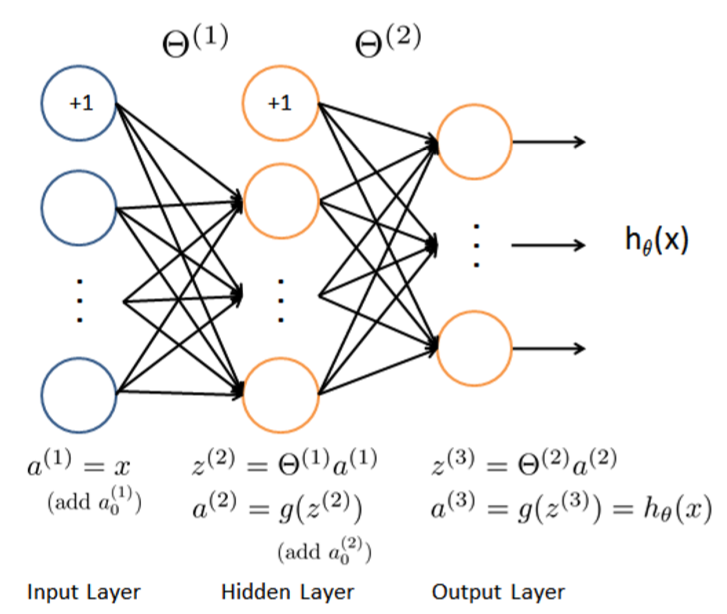Programming Exercise 4: Neural Networks Learning
带正则化的两层MLP,损失函数为交叉熵
sigmoidGradient
直接写Sigmoid函数的导函数即可
\[Sigmoid'(x)=Sigmoid(x)(1-Sigmoid(x))\]
function g = sigmoidGradient(z)
%SIGMOIDGRADIENT returns the gradient of the sigmoid function
%evaluated at z
% g = SIGMOIDGRADIENT(z) computes the gradient of the sigmoid function
% evaluated at z. This should work regardless if z is a matrix or a
% vector. In particular, if z is a vector or matrix, you should return
% the gradient for each element.
g = zeros(size(z));
% ====================== YOUR CODE HERE ======================
% Instructions: Compute the gradient of the sigmoid function evaluated at
% each value of z (z can be a matrix, vector or scalar).
g=sigmoid(z).*(1-sigmoid(z));
% =============================================================
endnnCostFunction

前向传播过程与Ex3一样,这里不再赘述
交叉熵损失函数
\[J(\theta)=\frac 1 m \sum_{i=1}^m\sum_{k=1}^K[-y_k^{(i)}log((h_\theta(x^{(i)}))_k)-(1-y_k^{(i)})log(1-(h_\theta(x^{(i)}))_k)]\]
\[\delta_k^{(3)}=a_k^{(3)}-y_k\]
若输入样本的真实分类为k,则\(y_k=1\),否则为0
\[\delta^{(2)}=(\Theta^{(2)})^T\delta^{(3)}.*g'(z^{(2)})\]
\[\Delta^{l}:=\Delta^{l}+\delta^{l+1}(a^{(l)})^T\]
\(\Delta^{l}_{i,j}\)表示第l层第j个结点到第l+1层第i个结点的参数,对应m个训练样本的梯度之和
则m个样本的平均梯度可以表示为
\[\frac \partial {\partial \Theta_{ij}^{(l)}}J(\Theta)=\frac 1 m \Delta_{ij}^{(l)}\]
再给损失函数加入正则化:
\[J(\theta)=\frac 1 m \sum_{i=1}^m\sum_{k=1}^K[-y_k^{(i)}log((h_\theta(x^{(i)}))_k)-(1-y_k^{(i)})log(1-(h_\theta(x^{(i)}))_k)]+ \frac \lambda {2m}[\sum_{j=1}^{s_2}\sum_{k=1}^{s_1}(\Theta_{j,k}^{(1)})^2+\sum_{j=1}^{s_3}\sum_{k=1}^{s_2}(\Theta_{j,k}^{(2)})^2]\]
\[\frac \partial {\partial \Theta_{ij}^{(l)}}J(\Theta)=\frac 1 m \Delta_{ij}^{(l)}+\frac \lambda m \Theta_{ij}^{(l)}\]
function [J grad] = nnCostFunction(nn_params, ...
input_layer_size, ...
hidden_layer_size, ...
num_labels, ...
X, y, lambda)
%NNCOSTFUNCTION Implements the neural network cost function for a two layer
%neural network which performs classification
% [J grad] = NNCOSTFUNCTON(nn_params, hidden_layer_size, num_labels, ...
% X, y, lambda) computes the cost and gradient of the neural network. The
% parameters for the neural network are "unrolled" into the vector
% nn_params and need to be converted back into the weight matrices.
%
% The returned parameter grad should be a "unrolled" vector of the
% partial derivatives of the neural network.
%
% Reshape nn_params back into the parameters Theta1 and Theta2, the weight matrices
% for our 2 layer neural network
Theta1 = reshape(nn_params(1:hidden_layer_size * (input_layer_size + 1)), ...
hidden_layer_size, (input_layer_size + 1));
Theta2 = reshape(nn_params((1 + (hidden_layer_size * (input_layer_size + 1))):end), ...
num_labels, (hidden_layer_size + 1));
% Setup some useful variables
m = size(X, 1);
% You need to return the following variables correctly
J = 0;
Theta1_grad = zeros(size(Theta1));
Theta2_grad = zeros(size(Theta2));
% ====================== YOUR CODE HERE ======================
% Instructions: You should complete the code by working through the
% following parts.
%
% Part 1: Feedforward the neural network and return the cost in the
% variable J. After implementing Part 1, you can verify that your
% cost function computation is correct by verifying the cost
% computed in ex4.m
%
% Part 2: Implement the backpropagation algorithm to compute the gradients
% Theta1_grad and Theta2_grad. You should return the partial derivatives of
% the cost function with respect to Theta1 and Theta2 in Theta1_grad and
% Theta2_grad, respectively. After implementing Part 2, you can check
% that your implementation is correct by running checkNNGradients
%
% Note: The vector y passed into the function is a vector of labels
% containing values from 1..K. You need to map this vector into a
% binary vector of 1's and 0's to be used with the neural network
% cost function.
%
% Hint: We recommend implementing backpropagation using a for-loop
% over the training examples if you are implementing it for the
% first time.
%
% Part 3: Implement regularization with the cost function and gradients.
%
% Hint: You can implement this around the code for
% backpropagation. That is, you can compute the gradients for
% the regularization separately and then add them to Theta1_grad
% and Theta2_grad from Part 2.
%
a1=[ones(1,m);X'];
z2=Theta1*a1;
a2=[ones(1,m);sigmoid(z2)];
z3=Theta2*a2;
a3=sigmoid(z3);
for i=1:m
for k=1:size(a3,1)
if(y(i)==k)
J=J-log(a3(k,i));
else
J=J-log(1-a3(k,i));
end
end
end
J=J/m;
J=J+lambda*(sum(sum(Theta1.*Theta1))+sum(sum(Theta2.*Theta2)))/(2*m);
ay=a3;
for i=1:m
for num=1:size(a3,1)
if(y(i)==num)
ay(num,i)=1;
else
ay(num,i)=0;
end
end
end
for i=1:m
delta3=(a3(:,i)-ay(:,i));
delta2=(Theta2'*delta3).*sigmoidGradient([1;z2(:,i)]);
Theta2_grad=Theta2_grad+delta3*a2(:,i)';
Theta1_grad=Theta1_grad+delta2(2:end)*a1(:,i)';
end
Theta1_grad=Theta1_grad/m;
Theta2_grad=Theta2_grad/m;
%Regularization terms
Theta1_grad(:,2:end)=Theta1_grad(:,2:end)+(lambda/m)*Theta1(:,2:end);
Theta2_grad(:,2:end)=Theta2_grad(:,2:end)+(lambda/m)*Theta2(:,2:end);
% -------------------------------------------------------------
% =========================================================================
% Unroll gradients
grad = [Theta1_grad(:) ; Theta2_grad(:)];
end